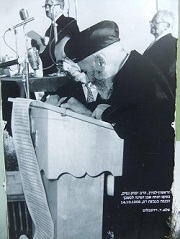Wrap Round First Knesset Building
Members of the first Israeli Knesset (Parliament) were elected in January 1949 and until the mid-1960s did not have a permanent home but wandered, in true Jewish fashion, from building to building – even from city to city – using the headquarters of the Jewish Agency in Jerusalem and even a cinema in Tel Aviv.
Eventually a more temporary permanent home was found a short walk down King George Street in Jerusalem from the Jewish Agency complex and for the first 16 years the Israeli Knesset was housed at Beit Froumine, a building constructed on land registered to the Israel Land Administration. In the summer of 1966 the Knesset moved to its permanent and present day building in the Givat Ram Government complex.
Nowadays the three floors of Beit Froumine, the former Knesset building of the 50s and 60s, are swathed in a gigantic material wrap stretched over almost invisible scaffolding. Hundreds of black and white photographs of the politicians and major events that occurred during the over decade and a half of the First Knesset's seat in Jerusalem are printed large and small, in a wrap-around history lesson appearing both on the wrap itself and in a series of two meter high wooden boards surrounding the bottom part of the building.
The fascinating up and down black and white presentation of a more than colorful country's political and ceremonial beginnings, led by personalities bigger than life and still spoken and argued about generations later, gives new meaning to the expression 'off the wall' as a gigantic photograph of Golda Meir in deep conversation with David Ben-Gurion, both of whom their hands clasped almost as if in prayer, rides high above a busy intersection of King George Street.
One can almost hear Golda Meir's smoke-fuelled gravelly American-accented voice coming down from on high as in the next gigantic but completely separate photo, and Menachem Begin, with his back to Ben-Gurion and Golda Meir, addressing fellow parliamentarians whilst the Knesset was still ensconced in this building.
Opposite Beit Froumine's main entrance, which is at the side of the building just off King George, is a small, tiered and quite deep park. The area was developed to receive a massive bronze Menorah sculpture created by German-born British sculptor Beno Elkan. The Menorah, weighing 4 tons, standing 4 meters high and at over 3 meters wide, was presented to the Israeli Knesset by the British government in 1956 and stood at that spot for a decade. When the Knesset moved to the Givat Ram building, the gigantic Menorah was relocated to the opposite side of the approach road in front of the main gates of the new building, still in an open public space so as to be accessible to all. It is one of the most photographed-in-front-of sculptures in the capital.
Nowadays, the pretty garden park originally created for Beno Elkan's Menorah is used by office workers as a lunch spot, by mothers and babies as a rest stop and play area, all overlooked by an enormous bronze statue of a horse who seems to be guarding the park where once a very special gift from Britain stood.
It was in Beit Froumine in 1957 that a mentally unstable man threw a hand grenade into the
plenum, seriously wounding the then Minister of Religious Affairs, Moshe Shapiro and
moderately wounding Ben-Gurion and others. Following the grenade attack the Knesset Guard was formed and protective glass panelling erected around the plenum.
As part of the photographic display on the boards in the street, First Knesset Speaker Joseph Sprinzak is seen leaving the building through the Knesset's main doorway and at his side is Yona Hatzor, the first armed Knesset Guard to take up duty. Poignantly, the board with the picture from the past fills that very entrance space, the first of a series of boards running adjacent to the pavement showing state funerals, festivities, functionaries and other First Knesset memorabilia over a 16-year period.
Following the move to the new Knesset, the Israel Ministry of Tourism used Beit Froumine until 2004, when it was sold to a private entrepreneur who had plans to bring in a wreckers ball and replace the historic building with apartments and shops. A struggle to save the building began in earnest, headed by the Council for Preservation of Israel Heritage Sites but also with solid support from present day and former Knesset members. This in turn lead to the Knesset Museum Law being legislated with the aim of returning the building to its 50s and 60s Knesset days of glory and eventually to become a state-funded museum.
It will probably take some time before the museum is actually up, running, and open to the general public. In the meantime the open air and open-to-all-exhibition of what is to come is readily available to residents and visitors taking a stroll down King George Street with time to read, absorb and reflect upon some of the leaders and State building events during an impressive period in modern Israel's history.
A sign, in Hebrew, Arabic and English, placed in a prominent position amongst the pictorial boards of yesteryear Israel, proclaims:
"Here will stand the Knesset Museum. The Knesset operated in this building between 1950 and 1966. The museum will display the Israeli legislature in its first years, during which the State of Israel's governing bodies were shaped on the basis of the values of Zionism, democracy and Judaism."











Comments